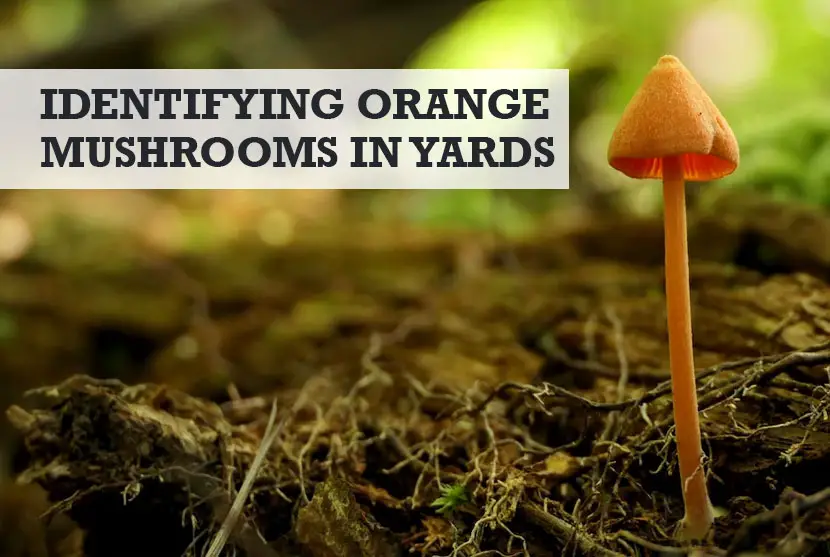The reasons why you have orange mushrooms in my yard is because you have fungi under your grass lawn’s surface. Orange mushrooms will grow in a backyard typically in wet seasons, and often very quickly after rainfall.
But knowing what those orange mushrooms are is also important, as some can be poisonous. I’ve spent time looking into the possibilities and have listed them below to help you with identification.
Before you proceed, never eat any mushrooms you find in your backyard unless you are sure they are edible. Many orange mushrooms are highly toxic.
And just because I have listed some as being non-toxic, that doesn’t mean they are safe to eat. Mushrooms will often vary wildly to the photos I have sourced so this content cannot be used as basis for eating anything you find growing in your backyard.
Backyard orange mushroom identification
Please be aware that every photo of an orange mushroom identified in this article can and will differ in appearance to those you might find growing in a yard. It should not be used as a guide for identifying edible orange mushrooms.
1. Jack-O-Lantern mushroom (poisonous)
There are some orange mushrooms growing in yards which are poisonous and should be handled with extreme care. The top of the list for toxic possibilities in a backyard is the Jack-O-Lantern mushroom, also known as Omphalotus Illudens.
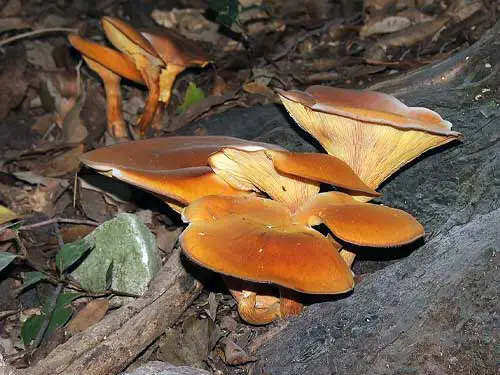
Thankfully it’s relatively simple to spot and differentiate from other orange fungi but does have a similar appearance to chanterelles. The most famous characteristic is also the reason for its unique name…
It has a bioluminescence that is seen in low light conditions. The orange beneath the cap of the mushroom will shine a blue-green color. This can make them very attractive to children, so it’s important your kids are aware of orange mushroom identification.
It will often be found growing on the decaying stumps of fallen trees or at the base of trees in Europe, North America, and South Africa.
2. Orange Peel fungus (non-toxic)
Orange Peel fungus is easy to identify as it has such a unique look to it. You will this orange mushroom in your yard between August and November, typically on grassy lawns and soil. It’s a hardy fungus and will also manage to grow on compacted soil near paths, and even on gravel.
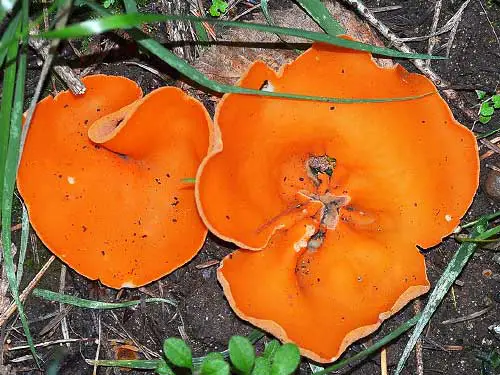
It’s not poisonous but can be confused with members of the Peziza family which are toxic, so as with any orange mushrooms, extreme care must be taken if you’re not sure.
3. Fly Agaric (poisonous)
The Fly Agaric is a risky orange mushroom found in yards because of the classic aesthetic appeal it has. Look at the photo and you will agree – it looks like the type of mushroom seen in fairy tales, making it very appealing to children.
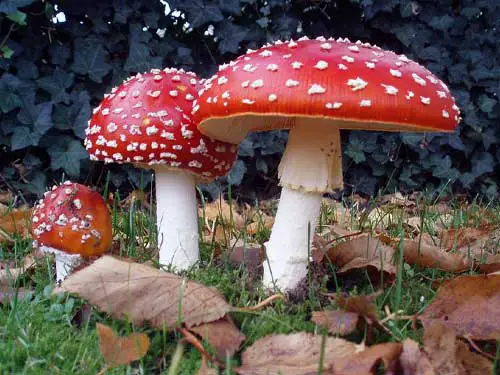
It has a bright orange to red cap, and white spots. This one is native to the UK, but is now also found in the United States, typically growing out of light soils near birch, pine, or spruce trees.
It is toxic and psychoactive. Here’s how Colorado University describe it:
“Fly agaric is listed as both poisonous and psychoactive. It synthesizes ibotenic acid and muscimol, which are both poisonous and psychoactive. Symptoms of poisoning include nausea, vomiting, dizziness, hallucinations, involuntary movements, delirium and seizures.”
4. Sulphur Shelf mushroom (non-toxic)
Also known as the “chicken of the woods”, this edible orange mushroom grows in large brackets on the bark of trees, usually oaks. And yes, the taste is apparently meant to be like chicken.
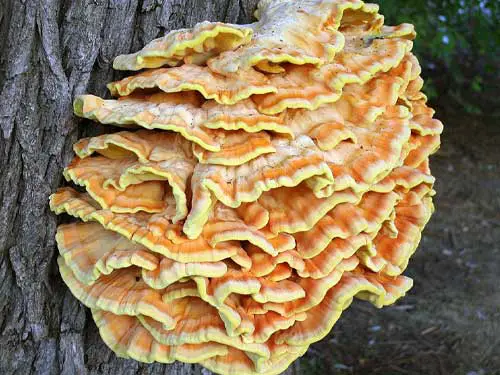
This is one of the easiest of orange mushrooms to identify due to the size of it. Some fungi brackets have been logged that weigh as over 100 pounds!
These orange mushrooms are only found growing in yards on trees such as oak, eucalyptus, yew, sweet chestnut, and willow, as well as conifers in some species.
5. Goblet Waxcap / Chanterelle Waxy Cap (non-toxic)
You might find these orange mushrooms in backyards in North America and Australia, appearing in late autumn on grass. They love backyards with mossy lawns.
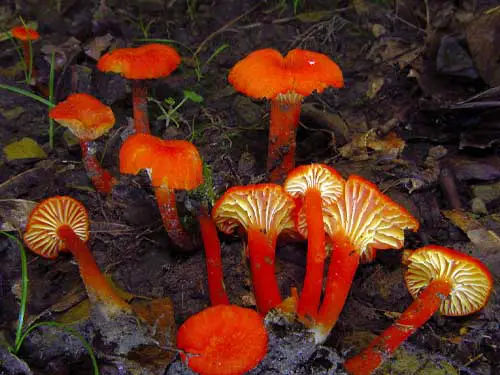
The orange mushroom identification with these is usually very easy. They are extremely bright in color and have a vase-shape and a long stem. Whilst not understood to be poisonous, so could be edible, by all accounts they don’t taste good at all.
6. Lobster Mushroom (non-toxic)
Despite the name, this orange mushroom is a parasitic ascomycete fungus. It can be found growing in yards on certain mushrooms, which then change into a orange and reddish color.
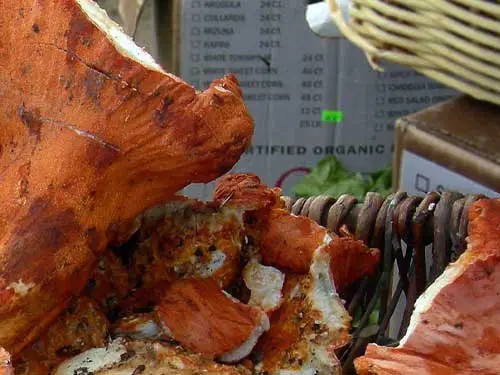
Whilst it’s often included on edible orange mushroom identification sheets, experts do say you should avoid eating them, despite there being no reports of poisoning in modern times.
It can be found attacking backyard mushrooms like Lactarius and Lactifluus (milk-caps), and Russula (brittlegills), turning them orange.
7. Jackson’s Slender Caesar (non-toxic)
This species of fungus has a reddish to orange cap, sometimes being described as an orange mushroom. It’s found yards as far north as Quebec in Canada, down through the United States, all way south into Mexican backyards.

It’s commonly found in woodlands where oak and pine grow, and the cap can grow as wide as 4 inches. It is said to be an edible mushroom, but please don’t try eating one from your yard unless you are 100% certain that’s what it is.
8. Scarlet Elf Cap / Molly Eye Winker (non-toxic)
Is relatively easy to identify this orange mushroom in your yard, due to the unique appearance. The fact it’s also called the eyelash fungus should give you a clue: the top of the mushroom is a small red to orange cup with dark hairs that resemble eye lashes.
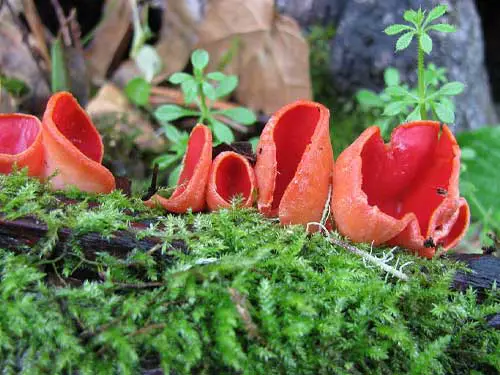
It will be found in damp backyards, typically underneath rotting leaves or near streams. It is a very small and is known to be a food source for rodents and slugs.
9. The Orange Bonnet (unknown if toxic)
This orange mushroom is frequently identified in yards on the eastern side of the United States. Its preferred habitat is along the swamp borders or streams, so will be found in backyards near water.
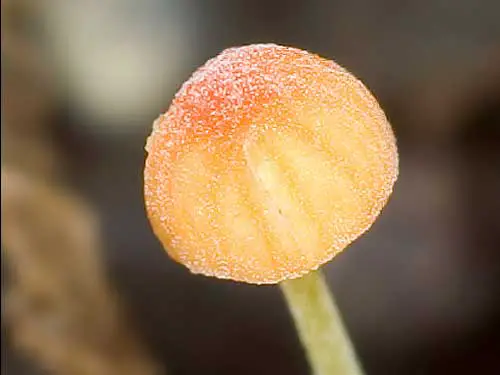
It is small with a tiny orange and red-colored cap, held up by a slender yellow-colored stem. The cap starts off as a rounded shape but will eventually grow into a bell shape.
These orange mushrooms are hard to spot in yards due to their size, and will typically grow on dead twigs and might be hidden beneath leaves.
10. Orange Oak Bolete mushroom (non-toxic)
Another orange mushroom in backyards could be this, also called Leccinum aurantiacum. However, it very much depends on where you live, as I don’t believe it’s found in North America, but can be occasionally seen growing in British and Irish yards.
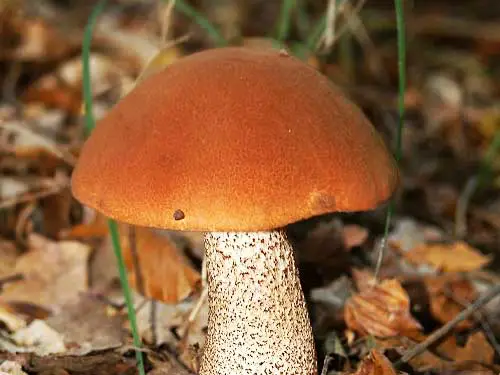
It has a large orange cap and a thick stem. You can identify this orange mushroom by where it grows in yards – in the main under trees including poplar, birch, and beech.
Whilst it’s described as being edible, some people have reported having stomach upsets after eating it so proceed with extreme caution.
11. Sulphur Tuft (poisonous)
This common woodland mushroom is bitter and poisonous, with side effects of consumption including vomiting and convulsions. If you do find this orange mushroom growing in your yard, steer well clear.
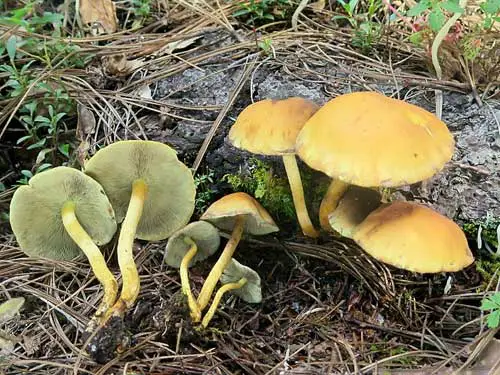
It grows on dead wood and is particularly abundant in woodland of North America and Europe. It can grow in yards between spring and fall (autumn) seasons.
12. Orange Mycena (unknown if toxic)
This orange mushroom is found in backyards of Australian and New Zealand homes. It’s identified by bright orange caps, stalks, and gills.
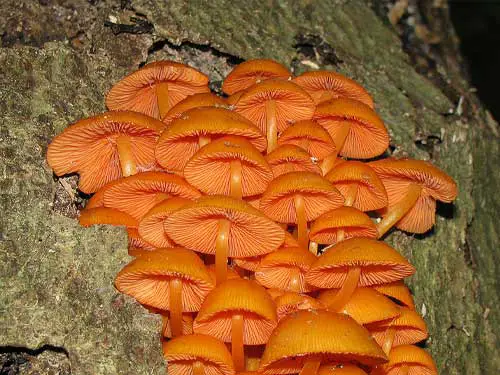
The mushrooms are small but will stand out in the distance as they grow in groups and are such a bright orange color. There’s a great write up and further description on the Tom Volk fungus blog.
13. Woolly Chanterelle (unknown if toxic)
This odd-looking orange mushroom grows into what is likened to a “vase” shape. It’s most identified in yards that border or are in coniferous forest areas. It loves to grow at the bottom of conifer trees.
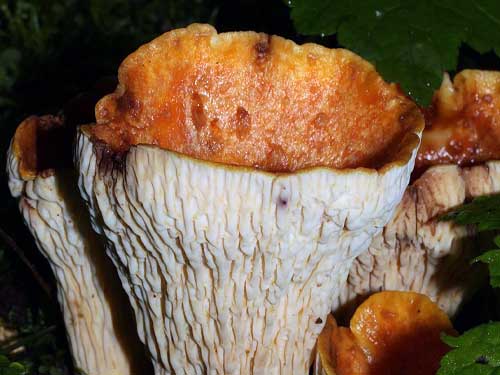
When considering this against a list of edible orange mushroom identification charts, do not eat it. Here’s what the First Nature website say.
“Although the False Chanterelle is not known as a seriously toxic toadstool, there are reports that some people have suffered hallucinations after eating this species. The False Chanterelle should therefore be treated with caution, and we recommend that it should be considered as inedible.”
14. The Golden Trumpet (non-toxic)
The last on my list of possible orange mushrooms you might find growing in your yard is a stunning looking species. As the name suggests, once flowered it has the appearance of an orange or golden trumpet.
It grows on decaying tree stumps and woody debris. They grow in the wet seasons and climates throughout North America.
Edible orange mushroom identification
Whilst care and attention has been taken to ensure the information presented in this content is accurate, please do not consider this an edible orange mushroom identification guide.
If you find any kind of orange mushrooms in your yard, do not eat them. You should always consult an expert in mushrooms and fungi to check if they are edible or not.
How to get rid of orange mushrooms in my yard?
There are several ways in which you can get rid of orange mushrooms in your yard, many of which are covered in-depth on other websites, so I won’t list them in full. I recommend a quick search of Google instead.
But I can offer a few tips. Firstly, if the orange mushrooms are non-toxic, I’d be inclined to leave them as they do more good than harm to a lawn.
If you do want to remove them the only truly effective way to do it is to excessively use chemicals and fungicides. But I think this is a terrible idea as will kill microbes and damage the ecology – it’s the nuclear option.
An alternative method is to remove the habitat in which orange mushrooms thrive in a backyard. That means sources of decomposing matter including trees, leaves, and roots.
What you might also want to consider is whether you are over-watering your yard’s lawn, making more mushrooms grow up on the grass than would normally.
To avoid this, consider using the 12321-lawn watering technique (OrganoLawn.com). This will keep your backyard’s grass watered, but lets the soil dry out between watering – so should help to reduce mushrooms.
Also avoid mowing over the top of the mushrooms as this can spread the spores over the yard more and into the mower itself, which spreads them more again. Mowing them can mean you get more orange mushrooms growing over a wider area.
Conclusion
Not all orange mushrooms are poisonous. But that doesn’t mean you should be complacent.
My content is intended to be a starter to help you understand better what’s growing in your backyard. You find more guides below.
More backyard guides…
Header image from https://unsplash.com/photos/GqKqPE-ewFg

